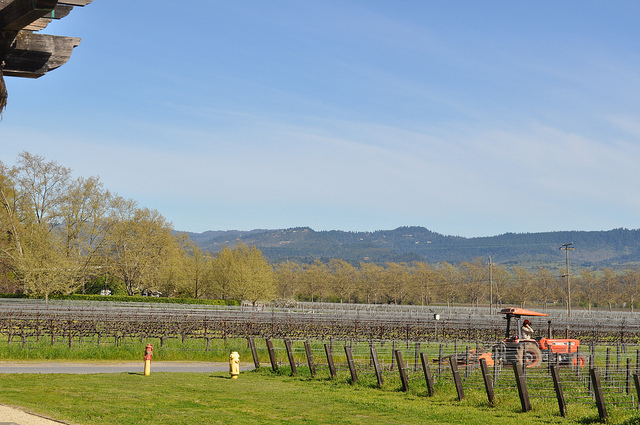An easement owner cannot claim another party has trespassed on their easement, because trespass involves interference with the plaintiff’s exclusive possession. Easement holders do not have a right to exclusive possession. They may claim nuisance, but only if the interference is substantial and unreasonable. But they can enlarge their rights by claiming prescriptive rights if they can show that they used the easement in a way that exceeded the use authorized in the grant of easement. These were the conclusions drawn by the court in a recent decision out of Napa County.
 In McBride v. Smith, McBride owned a landlocked parcel in a residential neighborhood in St. Helena, Google map here. She was the beneficiary of two recorded easements that run parallel to each other: the Secondary Access Easement encumbering the Smiths’ property; and the Driveway Easement located on property “owned by 1660 Spring Street,” which “remains in full force and provides access to the alley that connects both easements to Spring Street.”
In McBride v. Smith, McBride owned a landlocked parcel in a residential neighborhood in St. Helena, Google map here. She was the beneficiary of two recorded easements that run parallel to each other: the Secondary Access Easement encumbering the Smiths’ property; and the Driveway Easement located on property “owned by 1660 Spring Street,” which “remains in full force and provides access to the alley that connects both easements to Spring Street.”
The Smiths were not pleased. First, they constructed “wood dividers” along the “entire length” of the easement. Second, the Smiths erected a heavy chain and large pole at the end of the easement, with the chain extending the entire width of the easement. Third, the pole was bolted to the ground and could not be removed without special tools or a high amount of strength. Fourth, “[b]oth the pole and chain as they exist now obstruct Plaintiff’s access. Even if the chain was removed, the pole would still block Plaintiff’s access.”
McBride alleged that before the encroachments were installed, she and her predecessors used the Secondary Access Easement for “primary access purposes” for at least five years, openly, notoriously, under claim of right, and on a daily basis.
 TRESPASS
TRESPASS
Trespass is an invasion of the plaintiff’s interest in the exclusive possession of land. in order to state a cause of action for trespass a plaintiff must allege an unauthorized and tangible entry on the land of another, which interfered with the plaintiff’s exclusive possessory rights.
An easement “represents a limited privilege to use the land of another, but does not create an interest in the land itself.” Here, the defendants owned that land and McBride’s easement did not give her a possessory right.
She cannot establish that (1) she has an exclusive possessory right in the property comprising the Secondary Access Easement; or (2) the Smiths entry onto the Secondary Access Easement was unauthorized. The complaint allegations and judicially noticed facts established that this land is owned by the Smiths and that McBride does not have an exclusive possessory right to the property because her interest in it is limited to an easement.
An easement owner may sue to enjoin an obstruction or an unreasonable interference with her specific, limited, definable use of the easement by the servient owner. But the plaintiff did not do that in this case (oops!)
NUISANCE
A nuisance is defined by statute as “[a]nything which … an obstruction to the free use of property, so as to interfere with the comfortable enjoyment of life or property. California’s definition of trespass is considerably narrower than its definition of nuisance. “A trespass is an invasion of the interest in the exclusive possession of land, as by entry upon it …. A nuisance is an interference with the interest in the private use and enjoyment of the land and does not require interference with the possession.” The plaintiff’s lack of exclusive possession prevents a claim of trespass, but not nuisance. However, for nuisance there are two other factors -, the interference with use and enjoyment of land must be both substantial and unreasonable.
 McBride alleged that the Smiths “obstructed the free use of Plaintiff’s property so as to interfere with the comfortable enjoyment of her property, create visual blight and further obstruct the free passage over the 12’ Secondary Access Easement.” However, she still must plead and prove that the interference was both substantial and unreasonable.
McBride alleged that the Smiths “obstructed the free use of Plaintiff’s property so as to interfere with the comfortable enjoyment of her property, create visual blight and further obstruct the free passage over the 12’ Secondary Access Easement.” However, she still must plead and prove that the interference was both substantial and unreasonable.
PRESCRIPTIVE EASEMENT
The elements necessary to establish a prescriptive easement are well settled. The party claiming such an easement must show use of the property which has been open, notorious, continuous and adverse for an uninterrupted period of five years. A claimant need not believe that his or her use is legally justified or expressly claim a right of use for the use to be adverse. Instead, a claimant’s use is adverse to the owner if the use is made without any express or implied recognition of the owner’s property rights. In other words, a claimant’s use is adverse to the owner if it is wrongful and in defiance of the owner’s property rights.
The existence of the grant of an easement to McBride does not preclude her obtaining greater rights by prescription. Here, she alleged that she had used the 12’ Secondary Access Easement for primary access purposes for at least the last five (5) consecutive years openly, notoriously, under claim of right and/or color of title on a daily basis.
Using for the road primary access exceeds the secondary access use of the easement. Also, she alleged she used it daily. This was sufficient.
Photos:
flickr.com/photos/oldpatterns/3828832426/sizes/l
flickr.com/photos/vmperella/5627977012/sizes/z/
flickr.com/photos/mytravelphotos/5456769084/sizes/l
 California Real Estate Lawyers Blog
California Real Estate Lawyers Blog

